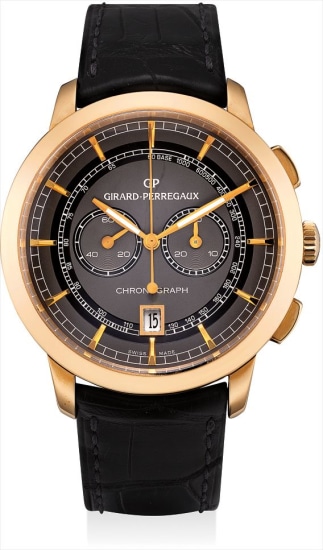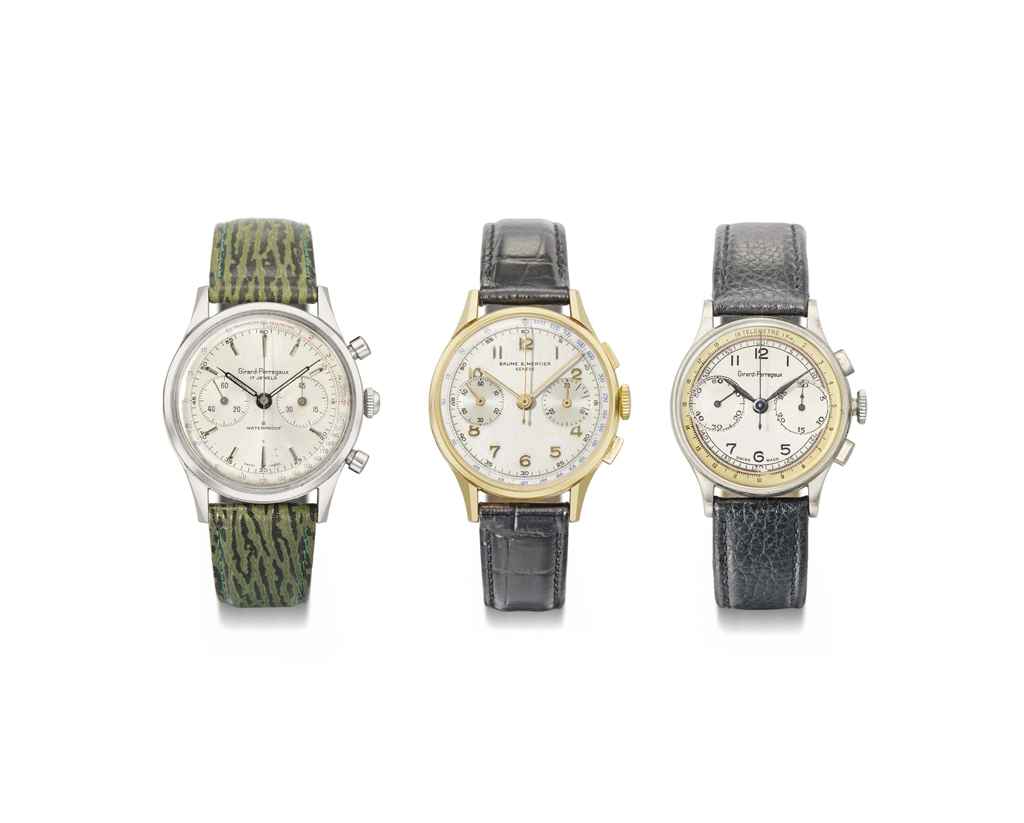Girard-Perregaux Follow An exceptionally rare and historically interesting yellow gold hunter case observatory three bridge tourbillon pocket watch with long pivoted detent escapement 芝柏,極罕有,18K黃金獵殼懷錶,配天文台陀飛輪及驅軸式擒縱裝置,“Three Golden Bridges”,1886年製 1886 62 mm. diameter Case, dial and movement signed; case further signed R. Waldvogel for the case maker
Manufacturer : Girard-Perregaux Year : 1886 Case No : 87'321 Model Name : Three Golden Bridges Material : 18k yellow gold Calibre : Mechanical Dimensions : 62 mm. diameter Signed : Case, dial and movement signed; case further signed R. Waldvogel for the case maker Literature : For a miniature three bridge tourbillon, please see Watches by George Daniels and Cecil Clutton, figs. 546-5. Catalogue Essay The present observatory tourbillon is of exceptional quality and is extremely well made. The condition is extraordinary, the dial is clear of any hairlines and the 5 joint case closes nice and tightly and the original engravings to both lids is very crisp. Overall this is a truly exceptional watch of historical importance. The long pivoted detent escapement was made by Ernest Guinand (c 1810-1879), which can be distinguished by the typical A-shaped frame that is always fitted with the pivoted detent escapements he was known for. Guinand also manufactured tourbillon carriages for the greatest watchmakers at the time, and it is rumoured that he was responsible for the first Patek Philippe tourbillon tested in 1867. Pivoted detent escapements were generally more fashionably used in Switzerland rather than England at the time. This is generally because the Swiss were brought up and trained how to make pivoted detent escapements where the English were taught how to make spring detent escapements. It is believed that the pivoted detent is more robust than the English spring detent. The pivoted detent was generally used at the time to avoid errors of rate with change of position in the watch. The idea behind the detent escapement is to increase accuracy. In a lever escapement, the escape wheel teeth and palette fork generate a lot of friction between them. The detent was designed to eliminate the palette fork and alter the balance wheel so that it will only interact the escapement once a second when changing direction. It is the detent that changes the direction of the balance wheel. Instead of a lever escapement that connects multiple times per second, the detent escapement only connects once per second, subsequently the friction of the parts were reduced. The outer case is finely engraved with the Argentinian Coat of Arms. The front is monogrammed with the initial N.A., which could stand for Nicolás Avellaneda, the president of Argentina from 1874 to 1880. The present watch really is of museum quality and in order to discover its importance, one needs to hold it in one's hand to marvel at its heavy case, pristine enamel dial and spectacular three bridge tourbillon. Read More
Girard-Perregaux Follow An exceptionally rare and historically interesting yellow gold hunter case observatory three bridge tourbillon pocket watch with long pivoted detent escapement 芝柏,極罕有,18K黃金獵殼懷錶,配天文台陀飛輪及驅軸式擒縱裝置,“Three Golden Bridges”,1886年製 1886 62 mm. diameter Case, dial and movement signed; case further signed R. Waldvogel for the case maker
Manufacturer : Girard-Perregaux Year : 1886 Case No : 87'321 Model Name : Three Golden Bridges Material : 18k yellow gold Calibre : Mechanical Dimensions : 62 mm. diameter Signed : Case, dial and movement signed; case further signed R. Waldvogel for the case maker Literature : For a miniature three bridge tourbillon, please see Watches by George Daniels and Cecil Clutton, figs. 546-5. Catalogue Essay The present observatory tourbillon is of exceptional quality and is extremely well made. The condition is extraordinary, the dial is clear of any hairlines and the 5 joint case closes nice and tightly and the original engravings to both lids is very crisp. Overall this is a truly exceptional watch of historical importance. The long pivoted detent escapement was made by Ernest Guinand (c 1810-1879), which can be distinguished by the typical A-shaped frame that is always fitted with the pivoted detent escapements he was known for. Guinand also manufactured tourbillon carriages for the greatest watchmakers at the time, and it is rumoured that he was responsible for the first Patek Philippe tourbillon tested in 1867. Pivoted detent escapements were generally more fashionably used in Switzerland rather than England at the time. This is generally because the Swiss were brought up and trained how to make pivoted detent escapements where the English were taught how to make spring detent escapements. It is believed that the pivoted detent is more robust than the English spring detent. The pivoted detent was generally used at the time to avoid errors of rate with change of position in the watch. The idea behind the detent escapement is to increase accuracy. In a lever escapement, the escape wheel teeth and palette fork generate a lot of friction between them. The detent was designed to eliminate the palette fork and alter the balance wheel so that it will only interact the escapement once a second when changing direction. It is the detent that changes the direction of the balance wheel. Instead of a lever escapement that connects multiple times per second, the detent escapement only connects once per second, subsequently the friction of the parts were reduced. The outer case is finely engraved with the Argentinian Coat of Arms. The front is monogrammed with the initial N.A., which could stand for Nicolás Avellaneda, the president of Argentina from 1874 to 1880. The present watch really is of museum quality and in order to discover its importance, one needs to hold it in one's hand to marvel at its heavy case, pristine enamel dial and spectacular three bridge tourbillon. Read More

.jpg)


.jpg)

.jpg)
.jpg)
.jpg)




.jpg)
Try LotSearch and its premium features for 7 days - without any costs!
Be notified automatically about new items in upcoming auctions.
Create an alert